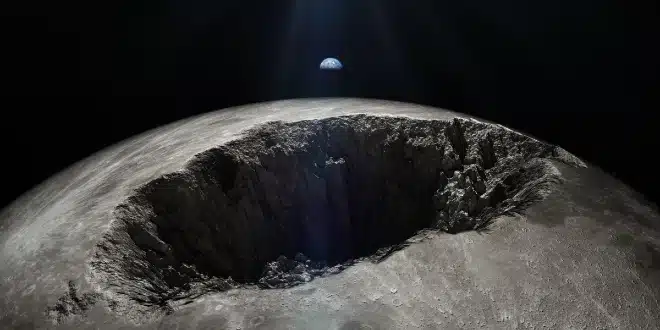While asteroid 2024 YR4 has temporarily slipped out of view, astronomers around the world remain highly focused on its projected path. Once considered a potential threat to Earth, this building-sized space rock now appears more likely to collide with the Moon sometime in late 2032. Though Earth is not in immediate danger, the possibility of a lunar impact has opened up new questions about how we prepare for and monitor cosmic hazards—not just to our planet, but to nearby space infrastructure as well.
From Earth Threat to Lunar Risk
Discovered in the final days of 2024, asteroid YR4 initially raised alarms with projections that suggested a possible Earth impact on December 22, 2032. The estimated probability peaked at 3.1% in February, briefly making it the most threatening asteroid ever tracked. But thanks to continuous observations from both ground-based and space telescopes, scientists were able to refine their calculations and rule out an Earth-bound trajectory.
The most recent set of observations—made in early June just before YR4 slipped beyond telescope range—has significantly sharpened projections of its future path. According to NASA, those updated measurements improved orbital accuracy by nearly 20%. While Earth is now safe, attention has shifted to the Moon, which lies directly in YR4’s potential path.
There is currently a 4.3% chance the asteroid could strike the Moon in 2032. Though the odds are still relatively low, the implications of such an event have caught the attention of scientists worldwide, especially as humanity pushes forward with plans for long-term lunar exploration.
Lunar Impact Could Send Debris Toward Earth
If YR4 were to hit the Moon, it would mark the most significant lunar impact in thousands of years. Measuring roughly 60 meters (about 200 feet) in diameter, the asteroid is not large enough to pose an extinction-level threat like the 10-kilometer asteroid that ended the age of dinosaurs. But it is still large enough to do considerable damage. Astronomers have dubbed it a “city killer,” as it could cause regional devastation if it ever struck Earth.
The Moon, unlike Earth, lacks an atmosphere to absorb or deflect impact debris. A direct hit from YR4 could create a crater nearly 1 kilometer (0.6 miles) wide, comparable to Arizona’s Meteor Crater. Simulations suggest the impact could eject up to 100 million kilograms (220 million pounds) of lunar rock and dust into space.
While Earth would not face any serious physical threat from this debris, fragments from the impact could pose hazards to astronauts on the Moon or to satellites and spacecraft in orbit. The International Space Station is expected to be decommissioned by then, but any future missions in low-Earth orbit could be vulnerable to fast-moving lunar particles. Likewise, human habitats or infrastructure on the Moon—such as those envisioned under NASA’s Artemis program—might be at risk from high-speed debris showers.
Expanding the Scope of Planetary Defense
The evolving story of 2024 YR4 is not just a lesson in orbital mechanics—it’s a wake-up call for planetary defense strategy. Until now, most asteroid tracking efforts have focused on identifying threats to Earth. But with humanity’s reach extending toward the Moon and beyond, experts believe it’s time to broaden our defensive framework.
“This case is helping us realize we need to expand the planetary protection model,” said Dr. Paul Wiegert, an astronomy professor at Western University in Ontario. “We now have more to protect than just the Earth. Our focus must include nearby space environments where people and valuable technology may exist.”
Astronomers are still studying what a YR4 lunar collision might look like. If it strikes the Moon’s near side—the hemisphere that always faces Earth—the impact could produce a flash bright enough to be seen without a telescope. According to Wiegert, the burst of light might last several seconds and be visible from Earth with the naked eye.
A Rare Opportunity for Real-Time Observation
One of the key contributions to tracking YR4’s path came from the James Webb Space Telescope (JWST). Its ability to detect faint objects over long distances allowed researchers to continue observing the asteroid after ground-based telescopes lost sight of it. With JWST data, astronomers were able to refine YR4’s orbital path with much greater accuracy.
“Size equals energy,” explained Julien de Wit, a planetary scientist at MIT who helped analyze YR4 using the Webb telescope. “Knowing the asteroid’s dimensions helps us better estimate the magnitude of the explosion it could cause.”
While astronomers have seen small impacts on the Moon before—usually from much smaller objects—YR4’s potential collision would offer an unprecedented chance to observe a large-scale lunar impact as it unfolds. If confirmed, it could provide valuable scientific insights into lunar geology, crater formation, and how debris behaves in the vacuum of space.
Looking Ahead: What Can Be Done?
With nearly a decade before the projected risk window in 2032, scientists have time to continue refining YR4’s path. They also have an opportunity to assess whether any mitigation strategies—such as deflection or impact-prevention missions—are feasible, though such interventions are usually reserved for Earth-bound threats.
At the very least, YR4 has reshaped how experts think about space safety. No longer is planetary defense just about saving Earth; it’s about safeguarding humanity’s expanding presence in space.
As Wiegert noted, “We’re at the beginning of a new chapter in space awareness—one that includes not just where we live, but where we’re going.”


